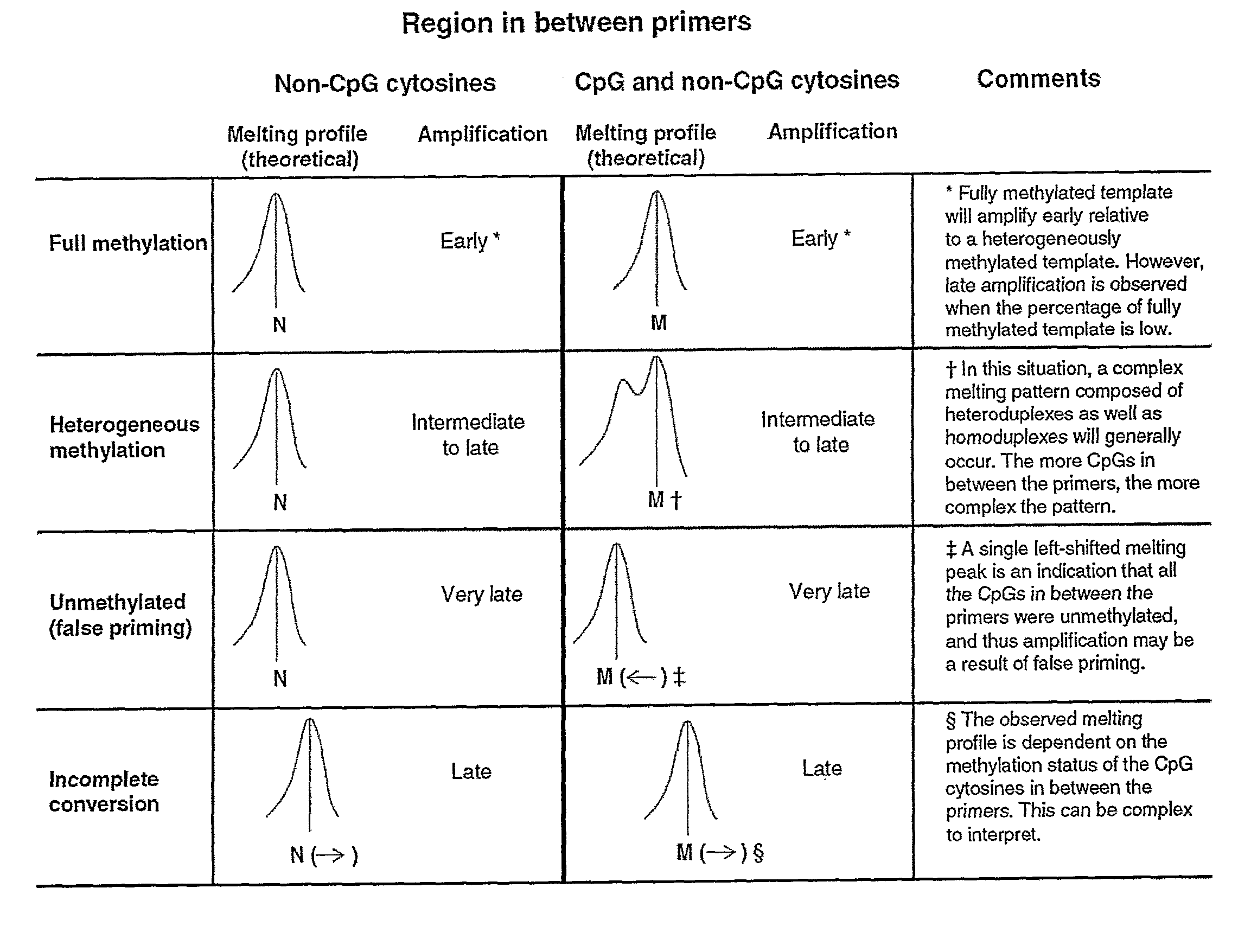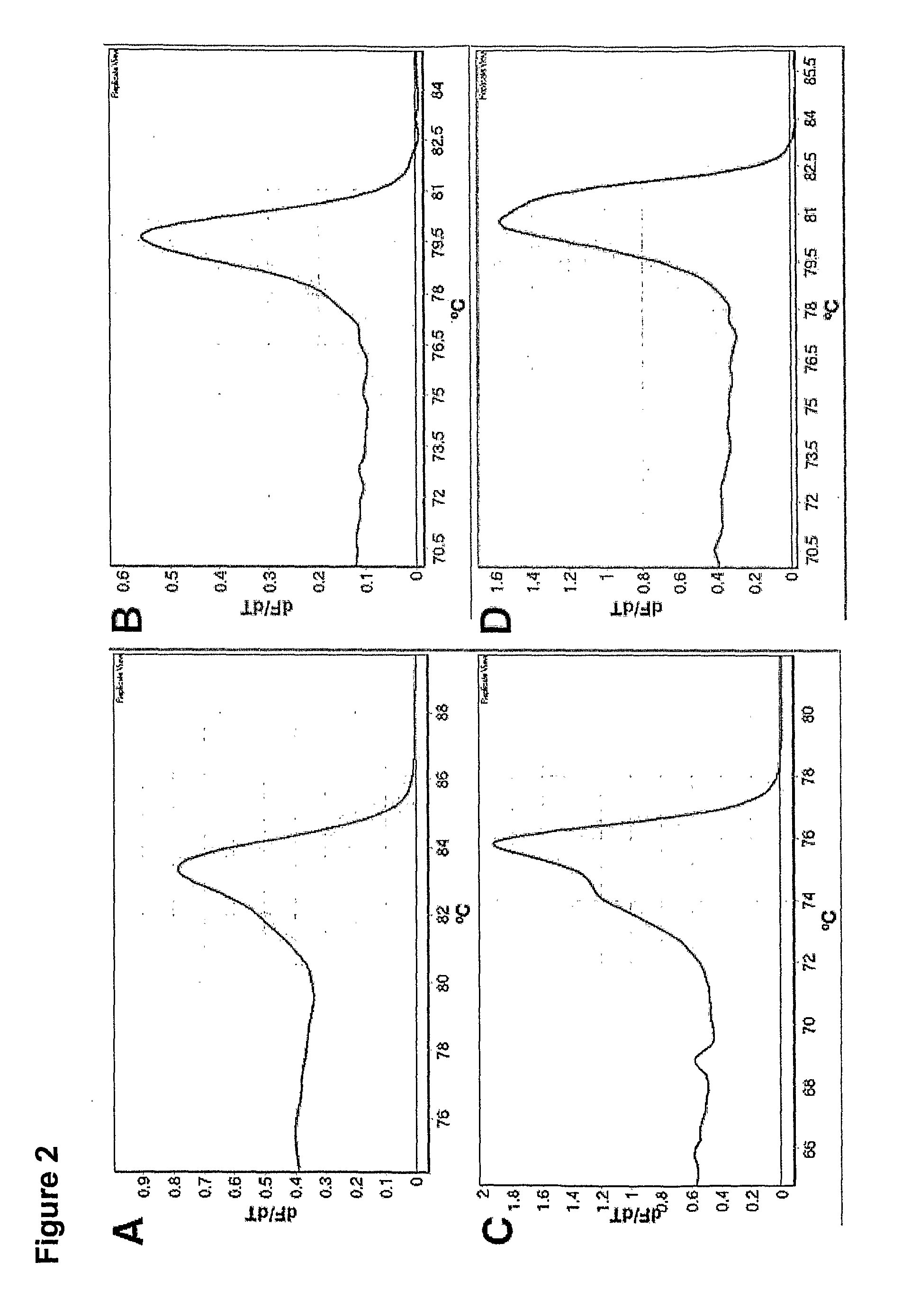Analysing Methylation Specific PCR by Amplicon Melting
a methylation specific and amplicon technology, applied in the field of methylation specific pcr by amplicon melting, can solve the problems of inability to detect pre-neoplastic and small malignant lesions using conventional methods, prone to false positives, and inability to detect pre-neoplastic and small malignant lesions
- Summary
- Abstract
- Description
- Claims
- Application Information
AI Technical Summary
Benefits of technology
Problems solved by technology
Method used
Image
Examples
example 1
The Sensitivity and Quantitative Accuracy of the SMART-MSP Assays
[0072]Assays have been developed for the promoter regions of the CDH1, DAPK1, CDKN2A (p16INK4a), and RARB genes as proof of principle. This example shows that highly accurate quantification is possible in the range from 100% to 0.1% methylated template when 25 ng of bisulfite modified DNA is used as a template for PCR.
[0073](a) Samples and DNA Extraction.
[0074]Purified genomic DNA from cell lines (2008, MCF7, Hs578T, MCF10A, MDA-MB-468, MDA-MB-231, MDA-MB-435, PC3, SKBr-3, Colo205, RPMI8226, SW948, HL-60, and T47D) was used. Universal Methylated DNA (Chemicon, Millipore, Billerica, Mass.) was used as a fully methylated positive control. DNA from peripheral blood mononuclear cells from normal individuals was used as unmethylated DNA for dilutions. Standard dilution series of 100%, 10%, 1%, 0.1% and 0.01% methylation levels were prepared by diluting the fully methylated DNA into the unmethylated DNA.
[0075](b) Bisulfite M...
example 2
Validation of the DAPK1 and CDKN2A SMART-MSP Conversion Control Assays
[0098]Bisulfite conversion can be assessed by melting analysis using assays with non-CpG cytosines between the primers. If a right-shift of the melting profile is observed, this can only be due to incomplete conversion of some or all of the non-CpG cytosines in between the primers or amplification of non-specific products (FIG. 1). Since incompletely converted products are of the same size as true positives, these can not be distinguished using gel electrophoresis. Incompletely converted DNA was generated to assess whether its amplification showed right-shifted melting profiles in these assays. Amplification was usually seen from these samples and always showed right-shifted melting profiles. The 100% methylated standard amplified earlier than incompletely converted DNA in both assays, and thus gave higher melting peaks (FIG. 5).
[0099]Bisulfite modified template melts early relative to unmodified template (FIG. 6)...
example 3
Identification of False Positives in the CDH1 SMART-MSP Assay
[0101]By running the CDH1 SMART-MSP assay for an additional 10 cycles, late amplification from the fully unmethylated control (WGA product) occurred. Since this WGA control is not methylated at the two CpG sites in between the primers, it was expected to see a readily distinguishable left-shifted melting peak, and thus to be able to identify it as a false positive result (FIG. 1). The melting peak of the unmethylated control (WGA product) was shifted approximately 1.2° C. to the left compared to the standards containing methylated template (FIG. 7).
[0102]False positive results due to false priming can be detected by HRM analysis as well, if CpGs are included in between the primers (FIG. 1). By running the CDH1 SMART-MSP assay for an additional 10 cycles, late amplification from the fully unmethylated control was seen. In this case, a left-shifted melting peak was observed due to the two CpGs found in between the primers be...
PUM
| Property | Measurement | Unit |
|---|---|---|
| volume | aaaaa | aaaaa |
| temperature | aaaaa | aaaaa |
| temperature | aaaaa | aaaaa |
Abstract
Description
Claims
Application Information
 Login to View More
Login to View More - R&D
- Intellectual Property
- Life Sciences
- Materials
- Tech Scout
- Unparalleled Data Quality
- Higher Quality Content
- 60% Fewer Hallucinations
Browse by: Latest US Patents, China's latest patents, Technical Efficacy Thesaurus, Application Domain, Technology Topic, Popular Technical Reports.
© 2025 PatSnap. All rights reserved.Legal|Privacy policy|Modern Slavery Act Transparency Statement|Sitemap|About US| Contact US: help@patsnap.com



